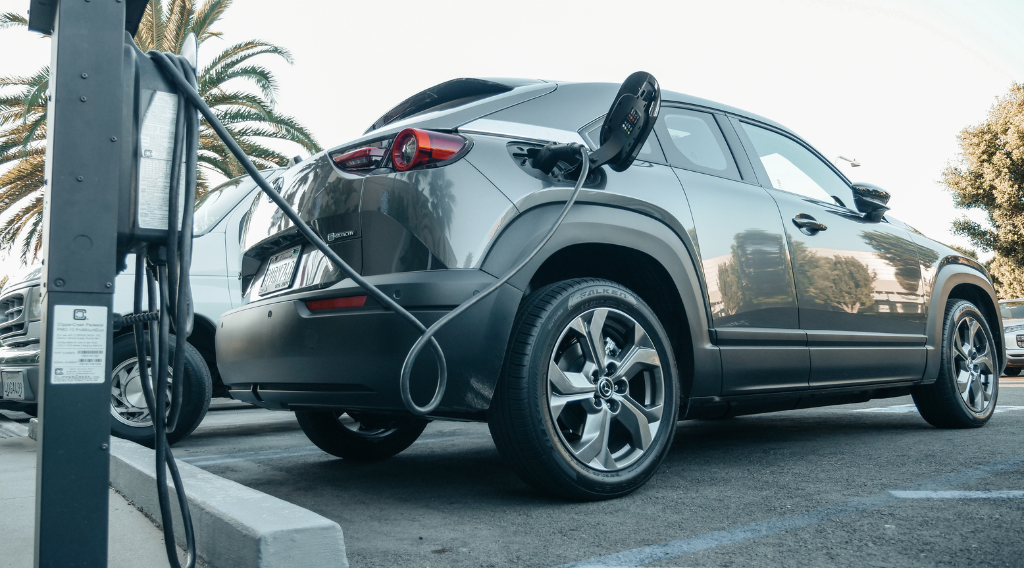Expanding Public Electric Vehicle Charging Through Right-of-Way Utilization
July 11, 2022 | Abby Hornberger | Education

Improving access to public electric vehicle (EV) charging is essential to increasing EV adoption for those who cannot rely on home charging, such as renters. Adding more EV chargers in the public right-of-way (ROW) is one way that local governments can increase access for drivers that cannot charge their vehicles at home. EV chargers in the ROW are often referred to as curbside charging or on-street charging. As local governments expand charging in the public ROW, they will need to find a balance with implementing bike and pedestrian infrastructure.
In crowded urban landscapes, renters often rely on street parking to park their vehicles, which is inconsistent and far away from any electrical panel. Access to a permanent parking space close to the building’s electrical panel is essential to installing home charging. Without access to a dedicated parking space with electricity, EV ownership is largely out of reach.
Local government projects to install curbside charging
Local governments can support more diverse EV owners by rethinking structures in the public ROW and considering how EV charging fits into their planning efforts. But many local governments are left wondering: How will EV charging coexist with bike and pedestrian rights of way or public transit?
Advocates for reducing vehicle miles traveled raise concerns about EV charging in the ROW conflicting with encouraging other modes of transportation like biking or walking. EV charging plans should be compared with other modal plans like bike, pedestrian, and transit plans to avoid conflicts such as tripping, crashes, or cords blocking paths.
Luckily, cities across the United States have successfully found ways to limit the space required to install curbside EV charging. Kansas City, Missouri’s Streetlight EV Charging in the City Right-of-Way pilot project uses the existing electrical wiring in streetlights to house EV charging. Using streetlights reduces construction activity and does not take up additional space in the ROW away from cyclists and pedestrians.
The pilot project will demonstrate how charging can be integrated with the streetlight system to provide curbside access for renters, multi-unit dwelling residents, and taxis or ride services. If successful, the project will demonstrate the benefits of curbside and on-street charging for cities.
In Minnesota, the City of Saint Paul partnered with the City of Minneapolis, HOURCAR, and Xcel Energy to create the EV Spot Network providing 70 on-street renewably-powered EV Spot Charging locations and over 150 free-floating Evie Carshare vehicles throughout communities in Saint Paul and Minneapolis.
The program offers EV owners the ability to access and use 38 on-street EV Spots in Saint Paul and 32 EV Spots in Minneapolis to charge their personal vehicle for a small fee. The project was funded by the US Department of Energy through the American Lung Association and Minnesota Clean Cities Coalition, which has partnered with local organizations like HOURCAR.
Overcoming barriers in Metropolitan areas
WXY architecture + urban design and Barretto Bay Strategies produced a report for the New York City Department of Transportation and the New York City Mayor’s Office of Sustainability titled Curb Enthusiasm: Deployment for On-Street Electric Vehicle Charging. The report outlines the barriers and development guidelines to large-scale adoption of EV infrastructure in metropolitan areas. Additionally, there are recommendations provided for how to establish a public access charging network.
Achieving cohesive use of space in the public ROW with EV chargers
City planners can work collaboratively with community members and organizations to integrate EV charging, bike, and pedestrian infrastructure in the ROW of city landscapes. In-depth community outreach and consultation enables EV charging use to coexist with other interests. When coupled with other public charging options, curbside charging stations will provide EV drivers without access to home charging with a reliable network to conveniently charge their vehicles near homes, workplaces, and shopping locations.
